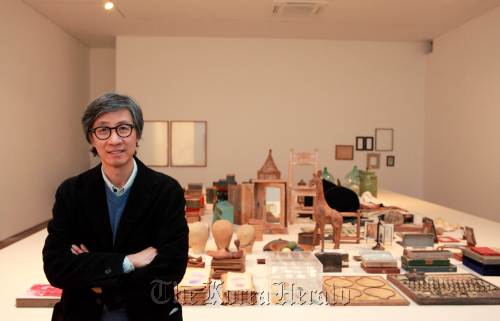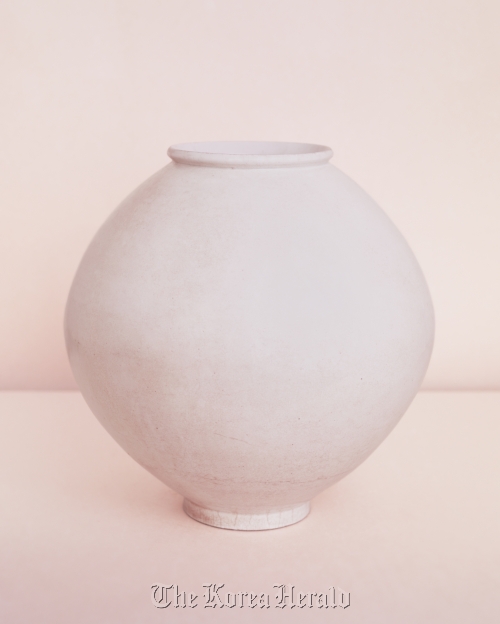Photographer Koo talks about finding beauty in bric-a-brac as he opens exhibition of his collection of miscellaneous objects
As a boy, Koo Bohnchang liked to explore his father’s front yard alone rather than playing ball with his friends, a constant cause of concern for his parents.
Little did they know that their boy would grow up to be a famous photographer.
Koo, who is now 58 and a professor at Kyungil University, is one of the most acclaimed photographers in Korea, and is best known for his “Moon Jar” series.
As a boy, Koo Bohnchang liked to explore his father’s front yard alone rather than playing ball with his friends, a constant cause of concern for his parents.
Little did they know that their boy would grow up to be a famous photographer.
Koo, who is now 58 and a professor at Kyungil University, is one of the most acclaimed photographers in Korea, and is best known for his “Moon Jar” series.

His solo show which is ongoing at Kukje Gallery in Sogyeok-dong, central Seoul, is different from his previous shows, because it focuses on the person Koo rather than his work. It is, in a way, a retrospective exhibition that looks back on the photographer’s youth and tries to understand his attitude toward his work.
Items from his childhood ― a fake celadon vase, an old fan, a 1966 Tokyo Olympic guide book and a cassette in which he recorded the sounds from the movie “The Graduate” ― are the first ones to greet the visitors, encased in a clear plastic box near the entrance of the exhibition. Koo said that he has been interested in collecting things since he was only 6.

“I recorded the movie because I felt that Dustin Hoffman was like me, weak and unable able to adapt oneself into reality. I majored in business administration but was never satisfied. Though I was one of six brothers and sisters I never really enjoyed socializing,” said Koo.
“Instead, I loved to play alone, looking at different objects and finding beauty in them. I still have a vivid recollection of the garden of the Japanese-style house I lived in when I was young. When puddles formed between rocks, I used to look into them and imagine the lake and the mountains. That is probably why I became sort of a collecto-maniac. I talked with objects, not with other people,” said Koo at the press conference last Thursday.
Covers of old issues of English-language magazines, like Time, Newsweek, the Saturday Review or Life, are lined up on a wall. One of them, a 1970 December issue, is a special edition featuring “Photography Contest.” He was simply interested in art at that time and had no special goals, but maybe he knew he was going to become a photographer, Koo joked.
In a room further back is a big table full of miscellaneous objects ― photo subjects to Koo, but junk to anyone else. Dusty boxes, photo frames, mirrors, bottles and balls of thread are carefully lined up as treasures.
“A critic once called these ‘old and nameless.’ I thought it was such a fitting title. Here are my collection of objects that are supposed to carry something inside but are currently empty. These are things that no one hardly ever gives a glance to and you can’t even sell in antique shops. But my heart and camera always goes to things like these, tucked away in the corner,” said Koo.
Koo started photography when he was 27, studying abroad in Germany in 1980. He had worked at Daewoo Corporations for a few years but could not stand the dull life when his heart was always craving for art. He had no specific plans: He just flew over to Europe to study “art,” but photography just came to him there.
“The first time I felt happy in my life was when I attended photo classes in Germany. I had always been told off for my sensitivity and delicateness, but there, it was something to be praised for. I had found my hidden talent which could have never came out had I continued to work in a company. I honestly thought that I could die happily right then,” said Koo.
His first rolls of films which contain the cityscapes of Germany from 1980 to 1985 are screened in a small room. Across from that is another screen that shows Koo’s documentation of Seoul from when he first returned to the country, from 1985 to 1990. The photos reflect Koo’s affection and, at the same time, aloofness to both cities.
The exhibition continues on the second floor where five of Koo’s photographic series of other people’s collections are showcased. They include Japanese architect Itami Jun’s private collection of Moon Jars from The Museum of Oriental Ceramics in Osaka, Japan and Korean masks from the Musee Guimet in Paris, France.
“I am collecting their collections through my photos. Their aesthetic senses and passion for the collections are captured through my lens,” said Koo.
His recent interest is on families that were separated by war.
“I am planning to do a series on mothers who lost their sons in wars. I want to talk about the pain and sufferings of such families, which deepens with time,” said Koo.
The exhibition runs through April 30 at Kukje Gallery in Sogyeok-dong, central Seoul. For more information, call (02) 735-8449 or visit www.kukjegallery.com.
By Park Min-young (claire@heraldcorp.com)







![[Graphic News] More Koreans say they plan long-distance trips this year](http://res.heraldm.com/phpwas/restmb_idxmake.php?idx=644&simg=/content/image/2024/04/17/20240417050828_0.gif&u=)
![[KH Explains] Hyundai's full hybrid edge to pay off amid slow transition to pure EVs](http://res.heraldm.com/phpwas/restmb_idxmake.php?idx=644&simg=/content/image/2024/04/18/20240418050645_0.jpg&u=20240419100350)





![[From the Scene] Monks, Buddhists hail return of remains of Buddhas](http://res.heraldm.com/phpwas/restmb_idxmake.php?idx=652&simg=/content/image/2024/04/19/20240419050617_0.jpg&u=20240419175937)

![[KH Explains] Hyundai's full hybrid edge to pay off amid slow transition to pure EVs](http://res.heraldm.com/phpwas/restmb_idxmake.php?idx=652&simg=/content/image/2024/04/18/20240418050645_0.jpg&u=20240419100350)

![[Today’s K-pop] Illit drops debut single remix](http://res.heraldm.com/phpwas/restmb_idxmake.php?idx=642&simg=/content/image/2024/04/19/20240419050612_0.jpg&u=)